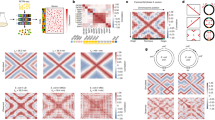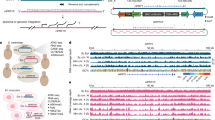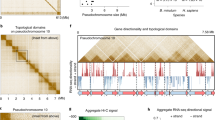Abstract
Recent advances have made a persuasive case for the existence of G4 DNA in living cells, but what—if any—are its functions? Experiments have established how G4 DNA may contribute to the biology of eukaryotic cells, and genomic analysis has identified new ways in which the potential to form G4 DNA may influence gene regulation and genomic stability. This Perspective highlights those advances and identifies some key open questions.
This is a preview of subscription content, access via your institution
Access options
Subscribe to this journal
Receive 12 print issues and online access
$189.00 per year
only $15.75 per issue
Buy this article
- Purchase on Springer Link
- Instant access to full article PDF
Prices may be subject to local taxes which are calculated during checkout





Similar content being viewed by others
References
Sen, D. & Gilbert, W. Formation of parallel four-stranded complexes by guanine rich motifs in DNA and its implications for meiosis. Nature 334, 364–366 (1988).
Gellert, M., Lipsett, M.N. & Davies, D.R. Helix formation by guanylic acid. Proc. Natl. Acad. Sci. USA 48, 2013–2018 (1962).
Schaffitzel, C. et al. In vitro generated antibodies specific for telomeric guanine-quadruplex DNA react with Stylonychia lemnae macronuclei. Proc. Natl. Acad. Sci. USA 98, 8572–8577 (2001).
Duquette, M.L., Handa, P., Vincent, J.A., Taylor, A.F. & Maizels, N. Intracellular transcription of G-rich DNAs induces formation of G-loops, novel structures containing G4 DNA. Genes Dev. 18, 1618–1629 (2004).
Paeschke, K., Simonsson, T., Postberg, J., Rhodes, D. & Lipps, H.J. Telomere end-binding proteins control the formation of G-quadruplex DNA structures in vivo. Nat. Struct. Mol. Biol. 12, 847–854 (2005).
Lee, J.Y., Okumus, B., Kim, D.S. & Ha, T. Extreme conformational diversity in human telomeric DNA. Proc. Natl. Acad. Sci. USA 102, 18938–18943 (2005).
Phan, A.T., Kuryavyi, V. & Patel, D.J. DNA architecture: from G to Z. Curr. Opin. Struct. Biol. 16, 288–298 (2006).
Wong, Z., Wilson, V., Patel, I., Povey, S. & Jeffreys, A.J. Characterization of a panel of highly variable minisatellites cloned from human DNA. Ann. Hum. Genet. 51, 269–288 (1987).
Huppert, J.L. & Balasubramanian, S. Prevalence of quadruplexes in the human genome. Nucleic Acids Res. 33, 2908–2916 (2005).
Todd, A.K., Johnston, M. & Neidle, S. Highly prevalent putative quadruplex sequence motifs in human DNA. Nucleic Acids Res. 33, 2901–2907 (2005).
Eddy, J. & Maizels, N. Gene function correlates with potential for G4 DNA formation in the human genome. Nucleic Acids Res. 34, 3887–3896 (2006).
Siddiqui-Jain, A., Grand, C.L., Bearss, D.J. & Hurley, L.H. Direct evidence for a G-quadruplex in a promoter region and its targeting with a small molecule to repress c-MYC transcription. Proc. Natl. Acad. Sci. USA 99, 11593–11598 (2002).
Rankin, S. et al. Putative DNA quadruplex formation within the human c-kit oncogene. J. Am. Chem. Soc. 127, 10584–10589 (2005).
Rawal, P. et al. Genome-wide prediction of G4 DNA as regulatory motifs: role in Escherichia coli global regulation. Genome Res. 16, 644–655 (2006).
Dempsey, L.A., Sun, H., Hanakahi, L.A. & Maizels, N. G4 DNA binding by LR1 and its subunits, nucleolin and hnRNP D: a role for G-G pairing in immunoglobulin switch recombination. J. Biol. Chem. 274, 1066–1071 (1999).
Hanakahi, L.A., Sun, H. & Maizels, N. High affinity interactions of nucleolin with G-G-paired rDNA. J. Biol. Chem. 274, 15908–15912 (1999).
Khateb, S., Weisman-Shomer, P., Hershco, I., Loeb, L.A. & Fry, M. Destabilization of tetraplex structures of the fragile X repeat sequence (CGG)n is mediated by homolog-conserved domains in three members of the hnRNP family. Nucleic Acids Res. 32, 4145–4154 (2004).
Zhang, Q.S., Manche, L., Xu, R.M. & Krainer, A.R. hnRNP A1 associates with telomere ends and stimulates telomerase activity. RNA 12, 1116–1128 (2006).
French, S.L., Osheim, Y.N., Cioci, F., Nomura, M. & Beyer, A.L. In exponentially growing Saccharomyces cerevisiae cells, rRNA synthesis is determined by the summed RNA polymerase I loading rate rather than by the number of active genes. Mol. Cell. Biol. 23, 1558–1568 (2003).
Sun, H., Karow, J.K., Hickson, I.D. & Maizels, N. The Bloom's syndrome helicase unwinds G4 DNA. J. Biol. Chem. 273, 27587–27592 (1998).
Sun, H., Bennett, R.J. & Maizels, N. The S. cerevisiae Sgs1 helicase efficiently unwinds G-G paired DNAs. Nucleic Acids Res. 27, 1978–1984 (1999).
Fry, M. & Loeb, L.A. Human Werner syndrome DNA helicase unwinds tetrahelical structures of the fragile X syndrome repeat sequence d(CGG)n. J. Biol. Chem. 274, 12797–12802 (1999).
Wu, X. & Maizels, N. Substrate-specific inhibition of RecQ helicase. Nucleic Acids Res. 29, 1765–1771 (2001).
Mohaghegh, P., Karow, J.K., Brosh, R.M. Jr., Bohr, V.A. & Hickson, I.D. The Bloom's and Werner's syndrome proteins are DNA structure-specific helicases. Nucleic Acids Res. 29, 2843–2849 (2001).
Crabbe, L., Verdun, R.E., Haggblom, C.I. & Karlseder, J. Defective telomere lagging strand synthesis in cells lacking WRN helicase activity. Science 306, 1951–1953 (2004).
Chang, S. et al. Essential role of limiting telomeres in the pathogenesis of Werner syndrome. Nat. Genet. 36, 877–882 (2004).
Mandell, J.G., Goodrich, K.J., Bahler, J. & Cech, T.R. Expression of a RecQ helicase homolog affects progression through crisis in fission yeast lacking telomerase. J. Biol. Chem. 280, 5249–5257 (2005).
Huber, M.D., Duquette, M.L., Shiels, J.C. & Maizels, N. A conserved G4 DNA binding domain in RecQ family helicases. J. Mol. Biol. 358, 1071–1080 (2006).
Cheung, I., Schertzer, M., Rose, A. & Lansdorp, P.M. Disruption of dog-1 in Caenorhabditis elegans triggers deletions upstream of guanine-rich DNA. Nat. Genet. 31, 405–409 (2002).
Ding, H. et al. Regulation of murine telomere length by Rtel: an essential gene encoding a helicase-like protein. Cell 117, 873–886 (2004).
Vaughn, J.P. et al. The DEXH protein product of the DHX36 gene is the major source of tetramolecular quadruplex G4-DNA resolving activity in HeLa cell lysates. J. Biol. Chem. 280, 38117–38120 (2005).
Sun, H., Yabuki, A. & Maizels, N. A human nuclease specific for G4 DNA. Proc. Natl. Acad. Sci. USA 98, 12444–12449 (2001).
Liu, Z. & Gilbert, W. The yeast KEM1 gene encodes a nuclease specific for G4 tetraplex DNA: implication of in vivo functions for this novel DNA structure. Cell 77, 1083–1092 (1994).
Ghosal, G. & Muniyappa, K. Saccharomyces cerevisiae Mre11 is a high-affinity G4 DNA-binding protein and a G-rich DNA-specific endonuclease: implications for replication of telomeric DNA. Nucleic Acids Res. 33, 4692–4703 (2005).
Larson, E.D., Duquette, M.L., Cummings, W.J., Streiff, R.J. & Maizels, N. MutSalpha binds to and promotes synapsis of transcriptionally activated immunoglobulin switch regions. Curr. Biol. 15, 470–474 (2005).
Zaug, A.J., Podell, E.R. & Cech, T.R. Human POT1 disrupts telomeric G-quadruplexes allowing telomerase extension in vitro. Proc. Natl. Acad. Sci. USA 102, 10864–10869 (2005).
Oganesian, L., Moon, I.K., Bryan, T.M. & Jarstfer, M.B. Extension of G-quadruplex DNA by ciliate telomerase. EMBO J. 25, 1148–1159 (2006).
Lipps, H.J., Gruissem, W. & Prescott, D.M. Higher order structure in macronuclear chromatin of the hypotrichous ciliate Oxytricha nova. Proc. Natl. Acad. Sci. USA 79, 2495–2499 (1982).
Baumann, P. & Cech, T.R. Pot1, the putative telomere end-binding protein in fission yeast and humans. Science 292, 1171–1175 (2001).
Wu, L. et al. Pot1 deficiency initiates DNA damage checkpoint activation and aberrant homologous recombination at telomeres. Cell 126, 49–62 (2006).
Hockemeyer, D., Daniels, J.P., Takai, H. & de Lange, T. Recent expansion of the telomeric complex in rodents: Two distinct POT1 proteins protect mouse telomeres. Cell 126, 63–77 (2006).
Lei, M., Podell, E.R., Baumann, P. & Cech, T.R. DNA self-recognition in the structure of Pot1 bound to telomeric single-stranded DNA. Nature 426, 198–203 (2003).
Opresko, P.L. et al. POT1 stimulates RecQ helicases WRN and BLM to unwind telomeric DNA substrates. J. Biol. Chem. 280, 32069–32080 (2005).
Ishikawa, F., Matunis, M.J., Dreyfuss, G. & Cech, T.R. Nuclear proteins that bind the pre-mRNA 3′ splice site sequence r(UUAG/G) and the human telomeric DNA sequence d(TTAGGG)n. Mol. Cell. Biol. 13, 4301–4310 (1993).
LaBranche, H. et al. Telomere elongation by hnRNP A1 and a derivative that interacts with telomeric repeats and telomerase. Nat. Genet. 19, 199–202 (1998).
Eversole, A. & Maizels, N. In vitro properties of the conserved mammalian protein hnRNP D suggest a role in telomere maintenance. Mol. Cell. Biol. 20, 5425–5432 (2000).
Enokizono, Y. et al. Structure of hnRNP D complexed with single-stranded telomere DNA and unfolding of the quadruplex by heterogeneous nuclear ribonucleoprotein D. J. Biol. Chem. 280, 18862–18870 (2005).
Duquette, M.L., Pham, P., Goodman, M.F. & Maizels, N. AID binds to transcription-induced structures in c-MYC that map to regions associated with translocation and hypermutation. Oncogene 24, 5791–5798 (2005).
Huertas, P. & Aguilera, A. Cotranscriptionally formed DNA:RNA hybrids mediate transcription elongation impairment and transcription-associated recombination. Mol. Cell 12, 711–721 (2003).
Li, X. & Manley, J.L. Inactivation of the SR protein splicing factor ASF/SF2 results in genomic instability. Cell 122, 365–378 (2005).
Acknowledgements
I thank members of my laboratory for provocative discussions, and the US National Institutes of Health for supporting our research on G4 DNA (R01 GM65988) and switch recombination (R01 GM39799).
Author information
Authors and Affiliations
Ethics declarations
Competing interests
The author declares no competing financial interests.
Rights and permissions
About this article
Cite this article
Maizels, N. Dynamic roles for G4 DNA in the biology of eukaryotic cells. Nat Struct Mol Biol 13, 1055–1059 (2006). https://doi.org/10.1038/nsmb1171
Published:
Issue Date:
DOI: https://doi.org/10.1038/nsmb1171
This article is cited by
-
G-quadruplex and 8-oxo-7,8-dihydroguanine across the genome: methodologies and crosstalk
Genome Instability & Disease (2022)
-
The DNA secondary structures at telomeres and genome instability
Cell & Bioscience (2020)
-
Mms1 is an assistant for regulating G-quadruplex DNA structures
Current Genetics (2018)
-
A Dual-Specific Targeting Approach Based on the Simultaneous Recognition of Duplex and Quadruplex Motifs
Scientific Reports (2017)
-
G4-Tetra DNA Duplex Induce Lung Cancer Cell Apoptosis in A549 Cells
Nanoscale Research Letters (2016)



